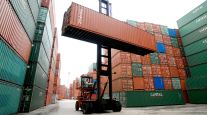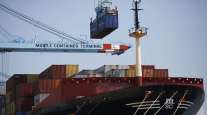Intermodal Projects Advance For Norfolk Southern Corp.
This story appears in the Sept. 6 print edition of Transport Topics. Click here to subscribe today.
Intermodal projects continue to march forward on the state level as two Norfolk Southern Corp. projects are advancing and a new intermodal terminal has opened in North Dakota.
Alabama, Mississippi, North Carolina, Pennsylvania, Tennessee and Virginia filed a combined application for $109.2 million in so-called TIGER II grants that could upgrade Norfolk Southern facilities. The railroad also announced it will open the Heartland Corridor double-stack train route on Sept. 9.
Meanwhile, the Port of North Dakota in Minot began operations on Aug. 24 with the receipt of 90 containers to load for export shipments. The first shipment was slated to leave the city on the Burlington Northern Santa Fe Railway’s east-west mainline on Sept. 3.
The six states in the Norfolk Southern project want the money from the Transportation Department’s Transportation Investment Generating Economic Recovery program, also known as TIGER. The railroad is developing the Crescent Corridor, a 2,500-mile rail system between Louisiana and New York that received $105 million in February.
“Public-private partnerships can create safe, practical, green improvements to America’s transportation infrastructure,” said Charles “Wick” Moorman, Norfolk Southern’s CEO.
“I commend and thank our partners for their recognition of the value the Crescent Corridor offers their states,” he said. “The Crescent Corridor Program is a tremendous economic advantage for the 15 states directly affected and the U.S. as a whole. It will create jobs and generate business growth, while delivering substantial public benefits for communities and customers.”
The corridor, named for a passenger train once operated by Norfolk Southern predecessor Southern Railway, is estimated to cost $2.5 billion in public and private funds. It’s intended to move 1.3 million longhaul shipments off key truck routes, such as Interstate 81.
The latest application covers terminal improvements in the Philadelphia and Harrisburg, Pa., areas and Charlotte, N.C. The rest of the money would be for track and signal improvements, the railroad said in a statement.
The $105 million Norfolk Southern received earlier in the TIGER I program is paying for intermodal improvements in Memphis, Tenn., and Birmingham, Ala.
TIGER grants were competitive in the first round, with nine applications for every approval. The Transportation Department awarded $1.5 billion in February for rail, highway and other projects. Rail programs received more than $300 million, about the same as the highway system.
The Heartland Corridor, linking Virginia ports to the Midwest, also is a public-
private deal, with state and federal money paying most of the $250 million to clear tunnels for double-stack trains between the Norfolk, Va., area and states such as Ohio.
The company plans a ceremony at the tunnel where construction began when the first double-stack train passes through it.
Funds for that program first were approved more than seven years ago, and construction began in Cowan, Va., during 2008.
The North Dakota project has taken even longer to get rolling.
Gregory Johnson, manager of the Port of North Dakota and president of North Dakota Port Services, told Transport Topics on Aug. 27 that he began working on the project in 1999 as an economic development effort initially focused on boosting agricultural exports in containers.
“It’s been an intense process for the past year,” he said, as the public-private venture completed a terminal and developed operational plans including drayage. “Getting the parties and the process together has been challenging.”
When the first batch of 90 empty Orient Overseas Container Line boxes arrived for loading, the terminal backers conducted a ceremony that included the state’s Republican governor, John Hoeven.
Ed Zaninelli, a vice president of the container carrier, and BNSF Vice President Fred Malesa also participated, Johnson added.
He said he hopes that once-weekly service frequency can increase as traffic builds.
In addition to agricultural products bound for Asia, freight to support the energy and defense industries in the area also can move through the North Dakota terminal with consumer goods such as furniture, Johnson said.
Moving empty containers to an inland area has been a stumbling block for the North Dakota project and others in areas far from intermodal hubs.
Johnson explained that, with OOCL onboard, there now is a source of containers for Minot, which is 900 miles from Chicago and more than 1,200 miles from Seattle and Portland, Ore., three locations where containers could be found.
One key reason the project is working now is because the recession forced shippers and carriers alike to make utilization improvements for containers and find new ways to fill them, such as with agricultural products.




